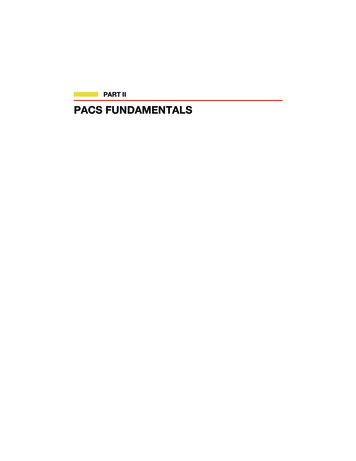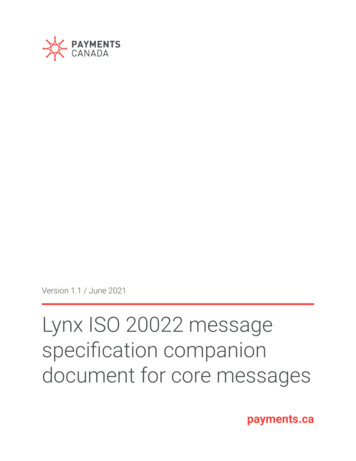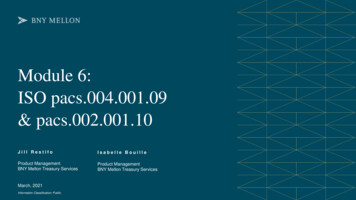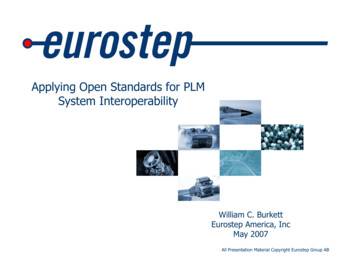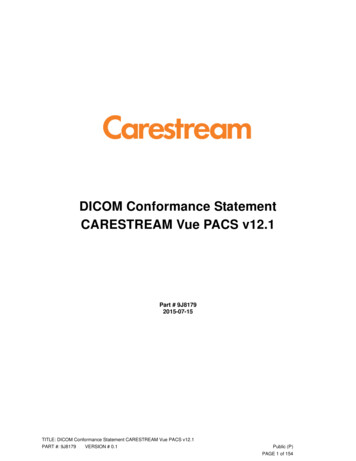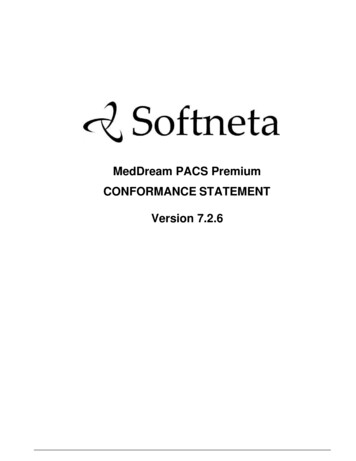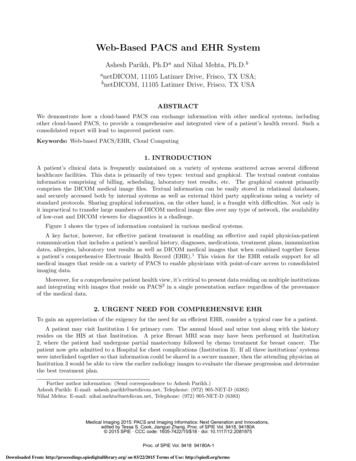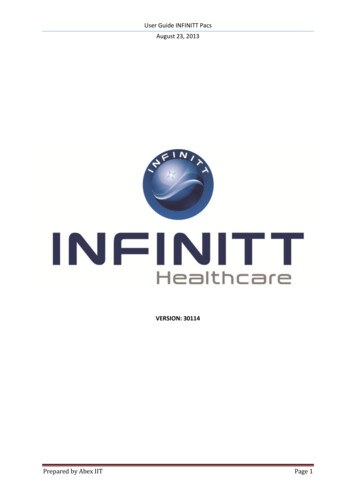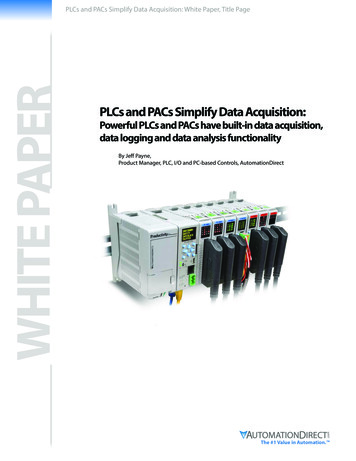
Transcription
WHITE PAPERPLCs and PACs Simplify Data Acquisition: White Paper, Title PagePLCs and PACs Simplify Data Acquisition:Powerful PLCs and PACs have built-in data acquisition,data logging and data analysis functionalityBy Jeff Payne,Product Manager, PLC, I/O and PC-based Controls, AutomationDirectThe #1 Value in Automation.
PLCs and PACs Simplify Data Acquisition: White Paper, pg. 2WHITE PAPERData acquisition, data logging and data analysis are required functions for mostmodern industrial control systems. The simplest and lowest cost way to provide thesefunctions is often by using the same platform that’s providing real-time control—namely the PLC or the programmable automation controller (PAC).A few years ago, this wasn’t possible as PLCs lacked the required processing power anddata storage capability. But more powerful PLCs and the evolution of PACs has made itpossible to perform many data acquisition tasks within the controller—saving moneyand providing an overall simpler system.PLCs have been controlling machines and processes for more than 30 years. Demandfor data and the need for real-time process information has increased during this time,and continues to grow rapidly in nearly every industry.End users need intelligence about their processes, machines and manufacturingoperations. They need to know about system alarms and events, about processvariables, and about production amounts. They need this information to make bettermanufacturing and business decisions in real time.Historically, acquisition of and access to this information was available only viaapplications with high-priced standalone supervisory control and data acquisition(SCADA) systems, third-party software, or expensive PC-based systems. But manymodern PLCs and PACs now have built-in data acquisition, data storage andnetworking capabilities—so accessing this critical information can be as simple asconnecting a PLC’s Ethernet port to a network, or pulling data from a removable USBmass storage device such as a USB pen drive.But this hasn’t always been the case. In the past, extracting data was a lot moredifficult, and much more expensive.Data Acquisition RootsOriginally, SCADA systems performed monitoring and control of geographicallydispersed system such as power transmission lines, oil and gas pipelines, water/wastewater systems, and the like. Older SCADA systems used remote telemetry unit(RTU) equipment, none of which had much intelligence by today’s standards. Theterm SCADA still conjures images of remote automation equipment installations,but when the term data acquisition is extracted from the acronym, it can take on adifferent meaning.The #1 Value in Automation.
WHITE PAPERPLCs and PACs Simplify Data Acquisition: White Paper, pg. 3Data acquisition systems acquire representations of real-world physical conditionsthrough inputs. Typically, sensors provide measurements that indicate how anobject or process behaves under specific conditions. Measured physical parameterscan be temperature, pressure, flow, pH, speed, force, sound level, and many otherprocess variables. Other parameters that can become data acquisition system inputsare electrical signal values such as voltage, current, resistance, power and otherrelated variables.Since there are so many types of real-world parameters that can be measured andanalyzed with data acquisition systems, input data almost always requires signalconditioning. Sensors convert physical parameters such as temperature, pressure, andflow to electrical signals. Even though physical parameters become electrical signals,most of the time their values are not consistent or compatible with the circuits thatmust measure them.Signal conditioning circuits accept sensor signals, apply the appropriate filtering andscaling, and further process signals if math functions or linearization are required.Many data acquisition input signals are analog, but some are digital, such as pulsesthat represent item counts or totalizer inputs. Analog signals, however, must beconverted to digital using analog-to-digital (A/D) converters. A/D converters convertanalog voltage or current signals to digital numbers proportional to the magnitude ofthe voltage or current.Analysis is where data acquisition startsto get tricky. Application requirementsdefine the type and method of dataacquisition as well as how collected data areanalyzed. For example, a production testengineer may use a portable data loggerto run a temperature conformity test ona heat treating furnace to ensure it meetsspecifications prior to shipment. A qualityengineer may extract archived statisticalprocess control data from a historian toensure that chemical plant products arewithin spec.Another basic function of data acquisition ispresentation. As with analysis, presentationImage 1. Early data acquisitioncanbe tricky because there are so manysystems were often associated withwidely dispersed assets like this oil andmethods, choices, and applications.gas pipeline.Presentation can take the form of atemperature readout on a panel meter; a graphical display on a human-machineinterface (HMI); or a report generated at the end of a run, shift, week, month orquarter. Presentation is often left to an external system by sending acquired data to ahistorian or an enterprise resource planning (ERP) system.The #1 Value in Automation.
PLCs and PACs Simplify Data Acquisition: White Paper, pg. 4Transferring acquired data to analysis and presentation systems can be complex, ascan performing those functions within a standalone data acquisition system.WHITE PAPERStandalone Data AcquisitionData logging is one type of data acquisition typically associated with dedicatedstandalone systems. In many cases, data logging is also associated with temporaryconfigurations such as lab or field testing, where test configurations and locationschange frequently.Product or system design engineers have used data logging in laboratoryenvironments for decades. Field engineers use data logging for many types oftemporary data gathering such as system error logging, power quality monitoring,system troubleshooting, commissioning, equipment or process verification, and manyother tasks.Typical Data Acquisition Applications1. Store, set, change and manage recipes2. Manage inventory3. Log and analyze production data4. Track, maintain and archive Key Performance Indicators5. Enable overall equipment effectiveness programs6. Log and archive test data7. Enhance quality control and audit tasksTable 1: Typical Data Acquisition ApplicationsMicroprocessor-based data loggers began to appear around 1975. Instead ofmeasuring and recording parameters individually, multiple readings could be takenin a relatively short period of time by scanning multiple inputs with each scannedsignal applied to a measurement circuit. Multiple-input scanning was accomplishedusing either relays or field-effect transistor (FET) switching, both based on scan andmeasurement times controlled by the data logging system.Both relay and FET methods have advantages and drawbacks. Relay scanners havelow contact resistance, are suitable for high-voltage applications, have excellentchannel-to-channel isolation and voltage stand-off, and shared one simple protectioncircuit—but they are slow. FET scanners have high resistance when switched, arelimited to low voltage applications, and have poor channel-to-channel isolation andvoltage stand-off—but they are fast.The #1 Value in Automation.
WHITE PAPERPLCs and PACs Simplify Data Acquisition: White Paper, pg. 5Image 2. Lab and test environments are a common area for data acquisition systems,often PC-basedStandalone data logging systems with switched measurement helped pave theway for a specialized field of data acquisition called automatic test equipment (ATE).Although there are differences between ATE and lab or field testing, they share manymore similarities. Because of the usefulness of ATE to manufacturing, especiallysemiconductors and electronics—it developed independently from other forms ofdata acquisition. Regardless, ATE still shares many similarities and characteristics withother types of data acquisition systems.Standalone systems still have their place as they can provide power and functionalitynot available elsewhere. For temporary data logging applications in particular,standalone systems are often the best solution. But in many cases, acquiring data withan existing control system is a better solution.Data Acquisition and Distributed ControlA DCS typically controls batch and/or continuous processes. Within the context of aDCS, data acquisition can take on several forms. As DCSs began to replace dedicatedcontrol computers in continuous processes such as refineries and chemical plants, themeanings of some of these terms began to evolve.Whereas the purpose of the DCS is to maintain control of the process—the purpose ofdata acquisition is to measure, analyze, and present. Sensing, signal conditioning andmeasuring must be done so the DCS can control the process. All that remains todata acquisition is to determine which parameters are meaningful to collect, and thenroute them to the appropriate channels. This would seem to make a DCS an idealplatform for data acquisition, and in many applications this is the case. If a processis controlled by an existing DCS, many data acquisition functions can be performedwithin that platform.The #1 Value in Automation.
PLCs and PACs Simplify Data Acquisition: White Paper, pg. 6WHITE PAPERFor data acquisition functions that can’t be performed within the DCS—connectivityoptions exist to link the DCS to other more specialized and powerful data analysis,reporting and presentation systems.But for processes not controlled by a DCS—it doesn’t make sense to use an expensive,high-powered and complex real-time control system just to perform data acquisition.PC-based Data AcquisitionShortly after the personal computer made its debut in the early 1980s, companiesbegan introducing add-on products such as multi-functional data acquisition cards forthe PC, disk-based storage units, and PC expansion chassis. PC-based measurementand data acquisition products were originally developed for lab, testing, and productdevelopment environments. Although PC-based data acquisition has expandedbeyond these applications, they remain primary markets.PC-based data acquisition is typically accomplished with one or more circuit boardsthat plug directly into the internal bus of the PC. Advantages of PC plug-in boardsinclude low cost and high speed. Disadvantages include the need for external signalconditioning, difficulty connecting to sensors, low isolation and protection, poor noiserejection, and poor expandability.The measurement chassis also falls within the PC-based data acquisition category, andit solves the expandability problem. Also typically used for lab and testing scenarios,measurement chassis have good noise rejection and isolation, but they usually costsignificantly more than plug-in boards.Early PC-based data acquisition hardware required extensive programming tointerface to data acquisition software. Now, most PC-based data acquisitionapplications include driver software to communicate with the hardware. Thedriver software simplifies data acquisition programming because it eliminates theneed to use complex commands or register-level programming.Data acquisition software must necessarily meet end-use criteria. Complex oradvanced applications may require custom programming in a developmentenvironment such as C or Visual Basic. But most applications can be handled byconfiguring off-the-shelf software programs.The drawbacks to PC-based data acquisition include the need for a PC, the cost ofpurchasing the application software, and the annual licensing fees. Long termmaintenance and replacement parts for PCs can also be problematic due to the everevolving nature of the platform. For many applications, these shortcomings can beaddressed by using PLC-based data acquisition.The #1 Value in Automation.
PLCs and PACs Simplify Data Acquisition: White Paper, pg. 7WHITE PAPERPLCs and PACsPowerful PLCs and PACs are designed to satisfy complex requirements brought onby today’s automation application demands. These controllers have evolved into fullfeatured systems that combine much of the functionality of traditional technologiessuch as SCADA systems, DCSs and PCs.Many applications that were strictly DCS-based can now be accomplished using theflexibility and functionality of PACs and powerful PLCs. As with DCSs—the sensing,signal conditioning, measuring, and analyzing is done within the controller and it’sI/O which is also used to control the process or machine. This double duty approachensures the lowest overall cost, smallest footprint and simplest data acquisitionsystem. PLCs and PACs perform basic data acquisition as part and parcel of real-timecontrol tasks. Extra I/O can be added to acquire data from areas that don’t requirecontrol, only monitoring. Data logging can be triggered by an event within the processor scheduled to occur at regular intervals.Once the data is collected, it can be stored locally at the controller, or it can betransferred to other systems. Data stored locally is usually saved to a USB pen orflash drive.Image 3. Modern and powerful PLCs and PACs can perform many of the dataacquisition functions formerly reserved for SCADA, PC-based and other systems.Data can be logged in a comma-delimited/comma-separated variable text file, or atab-delimited file. Users can include a date-and-time stamp and an alias for each dataitem sent. Data log files can be compressed into zip files that can be archived for easydata management.Users can view this data using Notepad, Excel, or other applications. Despite theproliferation of specialized data analysis software, Excel remains the most widely useddata analysis tool in manufacturing because of its familiarity and because most everyuser already has Excel installed on his or her PC.Data transfers from the controller to other systems are typically done by an Ethernetport, which is built-in to most every PLC and PAC nowadays. Popular protocols areThe #1 Value in Automation.
PLCs and PACs Simplify Data Acquisition: White Paper, pg. 8WHITE PAPERsupported negating the need to write complex drivers for the transfer of data fromthe controller to external systems.Some PLCs and PACs allow users to collect data via connection to networkeddatabase servers. Users can collect real-time data from processes or machines on theplant floor and store it in standard Microsoft Access-, SQL server-, or ODBC-compatibledatabases. Report-by-exception data logging allows direct communication betweenthe controller and the database—giving control of the data logging and storagefunctions to the controller allows it to send data only when needed in turn greatlyreducing network traffic.Benefits of PLC and PAC-Based DataAcquisition1. Performs control and data acquisition with single platform2. Low cost3. Small footprint4. Don’t need to buy and learn separate software package5. Don’t need to pay software licensing fees6. Doesn’t require database programming expertiseTable 2: Benefits of PLC and PAC-Based Data AcquisitionPLC Data Improves QualityAssociating a timeline to process variables can improve the quality of a product orreveal a quality problem. For example, one company chose a simple data loggingmethod to extract information from the PLC controlling its plastic injection moldingprocess. The company simply connected a removable USB pen drive to the dedicatedUSB data-out port of the PLC’s CPU.Using the data logging utility within the PLC’s software, companies have the capabilityto capture up to 64 process variable tags from the injection molding application eachtime they conduct their manual quality control inspections. By using an event bitwithin the PLC, they can control the exact time the data points are logged onto theUSB drive, which allows them to precisely coordinate the data collection with thequality control inspection.The user combines the process data and the quality control data into a single table ina spreadsheet application. From this table, they can correlate specific conditions andprocess variables to differentiate between good and bad product quality. After theycollect sufficient historical data, they can identify the critical variables that representthe key indicators in their quality management program.The #1 Value in Automation.
WHITE PAPERPLCs and PACs Simplify Data Acquisition: White Paper, pg. 9Using this procedure allows the company to monitor its plastic injection moldingprocess and make real-time adjustments when they notice conditions that would leadto poor quality products. Now, instead of using complicated high-priced systems andsoftware, this company is improving its overall product quality, reducing waste, andsaving money—all for the price of a USB pen drive and the ease of selecting a few tagnames in a table.These types of applications demonstrate the power of PLCs and PACs in dataacquisition applications. As these controllers increase their processing power, datamanipulation features and data storage capabilities—look for increased use in dataacquisition applications in manufacturing and process facilities worldwide.SummaryData acquisition, data logging and data analysis are required functions for mostmodern industrial control systems. The simplest and lowest cost way to provide thesefunctions is often by using the same platform that’s providing real-time control—namely the PLC or the programmable automation controller (PAC).PLCs have been controlling machines and processes for more than 30 years. Demandfor data and the need for real-time process information has increased during this time,and continues to grow rapidly in nearly every industry.End users need intelligence about their processes, machines and manufacturingoperations. They need to know about system alarms and events, about processvariables, and about production amounts. They need this information to make bettermanufacturing and business decisions in real time.About AutomationDirectIn business since 1994, AutomationDirect is a distributor offering thousands ofindustrial automation products for electrical control systems, including PLCs, operatorinterfaces, AC drives, motors, stepper systems, sensors, motor control, enclosures andmore. Their prices are typically well below the list price of more traditional automationcompanies because of their model and focus on efficiency and the majority of theirproducts are stocked for same-day shipping. Plus, get free two-day delivery on ordersover 49; some limitations apply. For more information, contact them at 800-633-0405or visit www.automationdirect.com/plcsThe #1 Value in Automation.
PLCs and PACs Simplify Data Acquisition: White Paper, pg. 3 . (FET) switching, both based on scan and measurement times controlled by the data logging system. Both relay and FET methods have advantages and drawbacks. Relay scanners have . low contact resistance, are suitable for high-voltage applications, have excellent .
